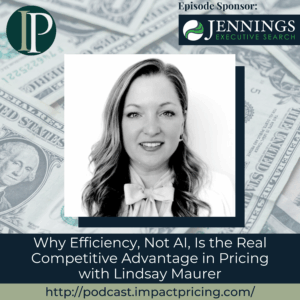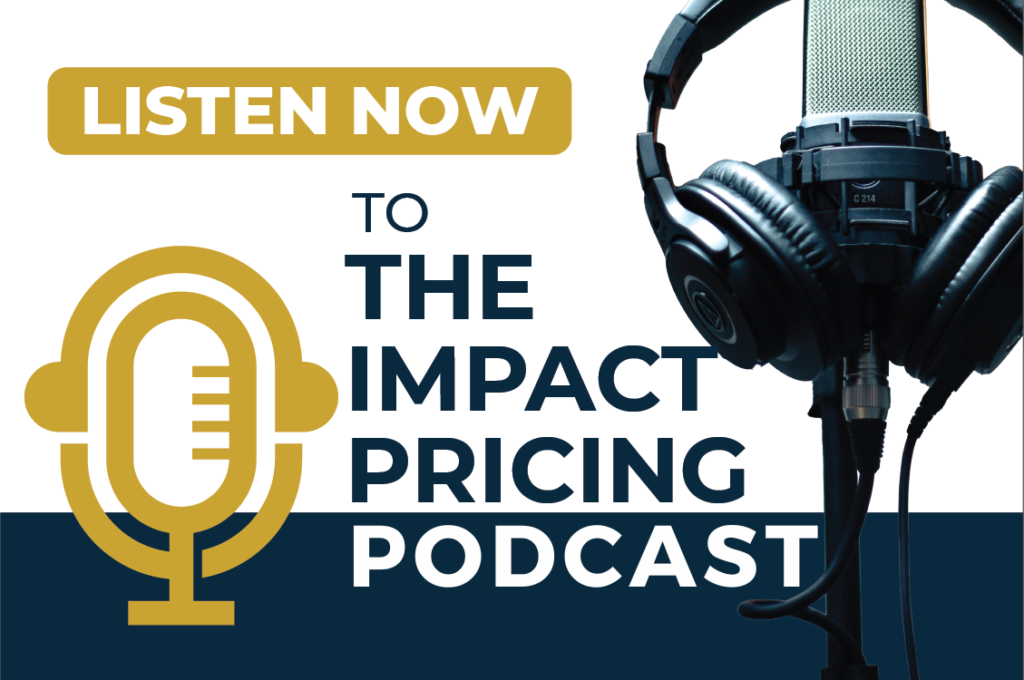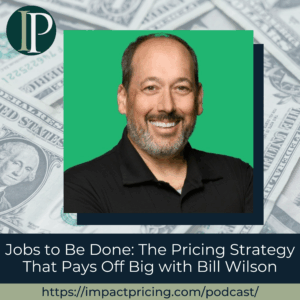
In this episode, Lindsay and Mark Stiving discuss regional pricing strategies, ethical competitive intelligence, and the power of price signals in the market. They explore what defines a pricing leader versus a follower, why clean data matters more than fancy tools, and why AI can’t fix bad pricing fundamentals.
Whether you work in pricing, lead a team, or simply want to understand how pricing shapes business strategy, this episode offers practical, real-world insights you can use right away.
Podcast: Play in new window | Download
Why you have to check out today’s podcast:
- Learn how to build regional pricing strategies that adapt to local competition and customer behavior.
- Discover smart, ethical ways to track competitors using tools like Circana data and web scraping.
- Understand why clean data and efficient processes matter more than any pricing technology.
“It doesn’t matter how much technology you throw at bad data — it’s not going to fix your pricing strategy.“
– Lindsay Maurer
Topics Covered:
02:50 – Getting into Pricing: How Lindsay’s career began and what got her hooked on pricing strategy.
06:10 – Inside the Role: What a Pricing Intervention Manager does – from fixing revenue leaks to supporting teams across the Americas.
12:15 – Market Dynamics: Why “the dumbest guy in the market sets the price” and how smart companies protect their margins.
15:08 – Retail Pricing: How retailers test price floors and ceilings, monitor competitors, and manage customer perceptions.
17:31 – Price Leadership: What makes a company a price leader versus a follower, and how market factors like tariffs shape decisions.
20:17 – Competitor Insights: How often to track prices in different industries and how to ethically gather market data.
25:01 – Strengthening Pricing Teams: Why efficient tools, clean data, and solid processes matter more than fancy systems.
28:25 – AI in Pricing: Where AI fits today, what it can and can’t do, and how to use it for smarter market insights.
29:57 – Pricing Community: Lindsay’s call for collaboration – connecting with other pricing professionals and sharing tools.
Key Takeaways:
“The dumbest guy in the market sets the price. If you have someone that has products that they can go and sell for half the price of yours, well, you’re also taking out half the price of everyone’s margin, but also your own.” – Lindsay Maurer
“Make sure you’ve got great information coming in. Make sure that you’re doing anything you can do with it as efficiently as possible so that when you do get those quotes and you do get those quick turnaround requests for sales that you can price quickly and you don’t lose business due to inefficiency.” – Lindsay Maurer
Resources and People Mentioned:
- Al Beck: Al Beck: Pricing Director at Standard Motor Products https://www.linkedin.com/in/alexanderkbeck/
- Circana (formerly NPD): https://www.circana.com
- Ficstar: https://www.ficstar.com/
- Import.io: https://www.import.io/
- SVP Recruiting: Organizer of Pricing Week conference https://svpricing.com/pricing-week
Connect with Lindsay Maurer:
- Website: https://www.bp.com/
- LinkedIn: https://www.linkedin.com/in/lindsaymaurer/
Connect with Mark Stiving:
- LinkedIn: https://www.linkedin.com/in/stiving/
- Email: [email protected]
Full Interview Transcript
(Note: This transcript was created with an AI transcription service. Please forgive any transcription or grammatical errors. We probably sounded better in real life.)
Lindsay Maurer
Make sure you’ve got great information coming in. Make sure that you’re doing anything you can do with it as efficiently as possible, so that when you do get those quotes and you do get those quick turnaround requests for sales, that you can price quickly and you don’t lose business due to inefficiency.
[Intro / Ad]
Mark Stiving
Welcome to Impact Pricing, the podcast where we discuss pricing, value, and the essential relationship between them. I’m Mark Stiving, and I run boot camps to help companies get paid more. Our guest today is Ms. Lindsay Maurer. Here are three things you want to know about Lindsay before we start. She is the Pricing Intervention Manager at BP. I have no idea what that is. We’re going to find out in a minute. She was a pricing manager at Standard Motor Products. And as you scroll through her LinkedIn, she has been in automotive pretty much her entire career. So welcome, Lindsay.
Lindsay Maurer
Yeah, thanks. Thanks for the intro, Mark. Much appreciated. And yeah, the two things I love the most, honestly, are the automotive space, a really unique market, and definitely pricing in that space is no shortage of complexity, no shortage of change as parts and cars have evolved over time. So definitely happy to be here, happy to bring any experience that I can to anyone who’s looking to learn either a little bit more about that industry or a little bit more about pricing in that industry.
The great news is, you know, a lot of the pricing concepts between industries often really do translate. A lot of the pricing approaches and methodologies, especially since many of the products that I’ve worked on are sold through retail, distribution, a lot of them are even, you know, consumer packaged goods in some cases. So a lot of the concepts actually do really transfer. So it’s not too narrow in the industry. And some of the things we’ll talk about today, a lot of people can pick up and take in their own industries as well.
Mark Stiving
Yeah. And actually, one of the things I love about the type of work I do is I see so many different industries and it’s really neat when you can watch one industry and say, why does that or won’t that work in a different industry? So I think everybody should be paying attention to all these different industries and the way they do pricing. So, excellent. Okay. So I always start with the question, how did you get into pricing? So how did you get into pricing?
Lindsay Maurer
Yeah, so pricing’s been some part of my role, geez, for about 14 years. And it started when I was in product management, a product specialist role. And it was a part of my role at that time. And I was at that time pricing out to, I think it was roughly about 60 different customers all over the world. All the product was being shipped from the US, so very much like an export pricing model, and trying to really develop a regional pricing strategy depending on where we were shipping, which parts of the world.
I was in my MBA at the time, so I was taking a lot of what I was learning at Xavier University and bringing it back to my job on a day-to-day basis, which was great, very hands-on learning and being able to apply what I was learning. But ultimately, that’s how I got started, and doing a regional model really meant, you know, hey, some of our customers in South America, what we were charging them would be very different than Asia, depending on the local influence and local availability of a similar product.
We ultimately had a premium product, so we were able to price premium because of the different stringent policies and things that we had in place and the rigorous engineering standards. So we were able to charge a premium, but we did have local competitors in some of the markets that would affect our pricing.
You know, in that role, as a simple example, I think what got me hooked, it’s like the best way I can answer this question, is we had a year where we actually saw revenue declines of around, I believe it was around 16%, and yet we saw profit gains around 13%. And the question for many businesses is, is that a good outcome? If you’re seeing revenue decline, but profit gain, it depends on what your goals are. But for me, being able to really put something in place that drove that type of instant gratification was really eye-opening to me, definitely. So that’s how I got hooked and have learned a lot along the way.
Mark Stiving
Well, so one of the things I want to make sure we don’t skip over because you just taught a really important lesson that I don’t know that people grasp. And that is, we set different prices in different regions based on how much people in that region are willing to pay us. And that willingness to pay has something to do with what competitors are we facing.
Lindsay Maurer
Yeah, a hundred percent. And I think a lot of times pricing as a role, you know, at the end of the day in business, someone has been deciding the price since the formation of businesses. Right. But as an actual discipline, I think it’s really only been about maybe 20, 25 years at most that we really had a dedicated function into looking into and understanding and leveraging, you know, market and consumer learnings into the price versus, hey, we’ll just do a cost plus. We’ve just got a cost increase. We want to leverage that into our products. It’s a little oversimplified.
And consumers have actually gotten so much more robust. You mentioned consumers being aware of the other options in a region. That definitely changes as everything becomes so much more readily available to us. All of us, I think, as consumers, we take a look around at prices. We do our own little research. Whether we realize it or not, we’ve really expanded and demanded that companies become better at pricing because of how all of us shop and research and how much we have available to us. It forces companies to really have to be more rigorous.
Mark Stiving
Yeah. Nice. Okay. So I promised I was going to ask this question. What the heck is a pricing intervention manager?
Lindsay Maurer
Great question. So I ask myself every day. No, I’m just kidding. So what we’re really focused on without, you know, giving away too much is essentially we have areas of the business that just need a little extra help and that we saw were struggling and whether that be, you know, promotion effectiveness or in some cases is looking at potential revenue leakage or segmentation, but it’s really identifying the key areas of the business that just needed a little extra support.
Whereas our, you know, our local pricing teams are already so busy and so overwhelmed and, you know, they’re doing a lot of great work and they just needed a little extra hand. So we have kind of a strategic layer that works alongside them to identify opportunities and really figure out how do we shift or adjust, whether it’s on the retail side of the business, the distributor side of the business, how do we adjust our pricing strategy or promotion strategies or even our discount strategies, whether we’re doing another example would be conditional versus unconditional rebates, things along those lines.
So it’s really looking at all of those things, everywhere from Canada, all the way down to Brazil. So that’s kind of the area I’m over. My role exists in other regions too, but ultimately when it comes down to it, everyone has a region they’re over that they’re kind of supporting in that way.
Mark Stiving
So it’s like you are an internal pricing consultant.
Lindsay Maurer
It’s exactly like that. Yeah. Yeah.
Mark Stiving
Yeah. Nice. Nice. Okay. So now a question that you had no idea I was going to ask this because I didn’t even know you worked in this industry. Sure. But I always teach, I ask the question, what happens to the price of gas when the price of oil goes up? And the answer, of course, is it goes up, but how fast? And the answer is it’s that day. So let’s have a conversation about that. Why does the price of gas go up the day the announcement is made that the price of oil is going up?
Lindsay Maurer
Yeah, so I can speak to what’s interesting is I’m actually not on the gas side of the business. A lot of people don’t realize BP has other areas, but I can definitely shed some light on it. A lot of it has to do with making sure that the costs are shored up immediately as soon as you can, right, because any delay that you have in increases is only going to hurt your bottom line. You’ve got to stay in step with the market as much as you can.
And honestly, every business should be looking to react the same way. Otherwise, you’re just bleeding off profit, right? If you’re seeing cost impacts to your business and you’re not looking to capture that in your margins or you’re not looking to, you know, maintain your margins, you know, it’s really essential that every business do that. But I’m actually working on the motor oil side of the business, also known as the lubricant side of the business. And so I’m actually not on the fuel side, but I do know enough to be dangerous to be able to answer that one, so.
Mark Stiving
Well, so how long does it take a drop of oil that comes out of the ground to make it to a gas station?
Lindsay Maurer
Oh, that’s a good question. I actually don’t know the answer to that one, Mark. I don’t. Do you? If you’ve been teaching on it, how long does it take?
Mark Stiving
So as I’ve done a little bit of research, it’s usually six to nine weeks, something like that. So it’s actually a long time. But what’s fascinating, and this is the interesting part, is that when the price of oil goes up, the price of gas goes up instantly, even though as a gas station, I’m not going to see that price increase for another six weeks, nine weeks, something like that, theoretically. But I teach it as it’s a signal, right, that all of the different gas stations are saying, hey, look, here’s a signal that we can go raise prices. Let’s go raise prices. So to finish the story, though, what happens when the price of oil goes down?
Lindsay Maurer
Yeah. And I think, you know, ultimately, I think everyone tries to hold on to their profits as long as they can. Right. I think that that is the easiest answer I have. And that’s universal. That’s no matter what industry you’re in. We always joke that, you know, anytime we have increases or decreases in any raw material. Right. Because on the lubricant side of the business, we actually can have many different things, you know, without giving away any proprietary information, but there’s many different elements that go into the products that we have.
And actually, base oil is just a very small percentage of it. It’s a lot of the additives and things that go into the actual motor oil that make a bigger difference in your pricing. But what we always say is whenever we have a price increase, customers want to wait, you know, 30, 60, 90 days, you know, whatever it might be, depending on your industry. But whenever you have a price decrease, my gosh, they’re ready to put it in that day. So, you know, it’s the same. It kind of doesn’t matter where you are in the channels. I think everyone is just trying to do their best to, you know, capture margin for the long term.
Mark Stiving
As they should be.
Lindsay Maurer
Those are my opinions. I wouldn’t say those are official positions of the company. So I’d probably refrain from putting those in. But, you know, ultimately it really is about capturing. Every company has to be working to capture the cost impacts to try and get those to market as soon as possible if they’re not able to be mitigated. And then also everyone always waits to see who’s going to go first. You or your competitor.
And one of my previous managers, a great guy that I worked for, his name’s Al Beck, and he was pricing director at Standard Motor Products for over 40 years. And he always says, you know, the dumbest guy in the market sets the price. And it is true, no matter what industry you’re in, because it’s that moment of, okay, we have cost changes up and down, and who’s moving first, right? And how low are they going to go if we have a decrease? How much of that is everyone taking to the market? And same goes for the increases, right? If you’re first to move on an increase, sometimes that can hurt you too.
So, you know, that willingness to move early, it has to go both ways to be fair in the market. But, you know, oftentimes everyone’s playing a little bit of that monitoring the market, looking at competitor pricing, trying to play that dance of do we move up now? Do we wait a little bit? And ultimately, you’ve got to decide as a company, are you a pricing leader? Are you a pricing follower? There’s nothing wrong with either. There’s pros and cons to both. But I think once you understand the strategy that the company wants to pursue, you know, you just move appropriately, right?
Mark Stiving
So can I just say, as you were talking, I was thinking about that statement. I love that statement. The dumbest guy in the market sets the price.
Lindsay Maurer
Yeah. Like I said, I can’t take credit for it, but one of the best managers I’ve had came up with that. And it’s true. You know, if you have someone that has products that they can go and sell, let’s say it’s half, they could sell it for half the price of yours. Maybe they’ve got a cost advantage or they’ve recently acquired someone. They’ve got a vertical integration, right? So their cost position looks better. And they decide, oh, I’m going to go capture all this volume. I’m going to go price at half the price of my competitor. Well, you’re also taking out half the price of everyone’s margin, but also your own.
So it’s always interesting. And it’s why I love pricing so much. The dynamics in the market watching, it’s never dull. There’s always something changing. But absolutely, you have those situations where you might have a competitor that goes and undercuts you or goes to the market at half the rate and is leaving all this margin on the table.
And like you said about signaling, a lot of the products that I’ve sold over the years or that I’ve been a part of pricing, are ending up in retail. So I can actually monitor, you know, publicly, retails are available online and you can monitor and say, oh, well, I see that, you know, retailer A, they moved their price down and their competitor didn’t follow them. And that’s a signal from that competitor. Just like you mentioned earlier, the signaling that goes on, you’ve got to be really astute to know that, okay, I moved down, my competitor didn’t for two to three cycles, you know, two to three months, you know, maybe it’s three to six weeks, depending on the industry you’re in. And when that happens, you’ve got a choice.
You know, as a retailer, do you bring your pricing back up or are you going to just leave all that margin out there? So it’s, you do see a lot of floor and ceiling testing in retailers and as a supplier to retailers for my, you know, last three roles, it’s always interesting to see them testing the ceiling and the floor of the market. And yeah, just the different conversations we can get into sometimes where retailer A might say, oh, well, Retailer B, you know, their price is lower, so you must be giving them a break, you know?
And come to find out, we do the research, and it’s like, oh, Retailer A lowered their price first. Their competitor didn’t follow. They came back up, and then their competitor followed later. And now they’re a little upset. It’s like, well, you guys are actually all getting roughly the same price. There’s no advantage, but you’re kind of playing with each other a little bit. So it’s always good to have, I know one of the things I mentioned to you is just the importance of market data. Because you can track and tell the story. You can understand more about what’s going on. And sometimes educate, you know, even educate or help your own customers understand what’s going on, which is so important, too.
Mark Stiving
So I always find competitive responses, competitive information fascinating. And so when you raise prices or if we go to retail, because it’s probably easier to think in retail, when you raise prices, can you actually determine or do you actually watch to see what your competitors do in response?
Lindsay Maurer
Yeah, so a lot of times in different roles, I’ll speak about it just kind of broadly across the different roles that I’ve had. Whenever I’ve made a recommendation to raise pricing out in retail, usually it’s with the understanding with a sales team or with, you know, the customer conversation that if we raise our price to you, you should be able to take this to the market and we should not, neither you nor us, should see negative impacts. If we’ve done our homework well, we should still be in line with competitors.
In a couple of my roles, I’ve been a pricing follower, so we haven’t been the first to move. So that’s always actually a little nicer. You can plan a little better. There is a little risk, like I mentioned earlier. If you incur the cost but you’re not recouping it quickly, you do see some lead off there in your margins. But ultimately, I think the benefit of being a follower is when it makes it easier on your sales teams, when they have to bring a price change to market, whether it’s per product or on a basket of goods, they’re able to more confidently, you know, share with the customer themselves that, hey, when we bring this change out, we’re going to be right in line with the market. We’re not going to be putting something through that’s going to be 10, 20% above competitors.
As a simple example, in one of the roles that I had, we had some simple targets like that. So, ultimately, I think that if you have an idea of back to your willingness to pay statement, is the perception of your brand, which is hard to track, but important to survey, it’s important to understand, is there a perception that you’re premium to X competitor? And can you do some testing, you know, 5, 10%, 15, 20, what’s the range of acceptable premium pricing to your competitor? You know, what is that willingness to pay?
But ultimately, that’s kind of how I’ve brought it around in the past is making sure that we’re taking something to the market. It’s competitive. It’s not ahead of competitors. It’s not above and beyond. You know, not to say that we don’t have, you know, in some cases or that we didn’t have in different roles a premium price that we would demand versus competition. But yeah, ultimately, I think it’s important to know your competitors and know what they’re doing and do creative strategy that keeps you in step with them. You don’t want to be too far out of whack.
Mark Stiving
So one of my favorite thoughts, and I talk about this a lot when I teach people how to raise prices, is the difference between a leader and a follower, of course. But one of my favorite thoughts is if you lead a price increase, do you know that your competitors will follow? And I just find that fascinating. Have you been in a situation where you’re like, yeah, we’ve got a strong brand. If we raise prices, then we know everybody in the market’s going to go raise prices.
Lindsay Maurer
I think it depends on the share you’ve got. I think it really depends on the share that you have in the market. If you’re a pricing leader, you know, by God, you better be also the volume leader and you better be able to swing around to say, hey, we know that if we’re going to do this, more of the volume in the market is going to be sold at this price. Now, if you’re a 5, 10 percent player, but you’re the first one to move all the time, you’re probably going to stay a 5 to 10 percent player. You know, competitors might not always follow you.
But really, if you’re a price leader, you’ve got to absolutely be the volume leader. You’ve got to be the big player in the market. And also in certain areas, I’ve seen it both ways. I’ve seen it where, yes, we know competition is going to follow us because maybe we’re sourcing from the same source. We’re experiencing the same cost impacts or cost pressures or tariffs are a hot topic right now. So there have been other roles that I’ve been in where we’ve had tariff impacts and we know that we are getting something from the same region as somebody else. They’re going to experience the same type of thing.
So there are certain elements where you can kind of guess that you’ll all move together, most likely. But then there’s also other situations where, you know, we would say we’re moving up in this price and we’re doing it for a strategic reason. And we wouldn’t always know if they would follow. Or maybe we have different sourcing. We have different dynamics going on in our cost structures or, you know, other elements that could be driving the back end.
But ultimately, many times we would do it knowing that there’s market conditions that are favorable, that everyone most likely is going to move this way. People may remember when the ocean freight surcharges were through the roof, you know, it was probably three or four years ago. They were, I don’t know, it was usually like, I think, maybe like, I feel like the numbers that stand out to me, it was like 4,000, you know, whatever it was to move a container, that got astronomically out of line, right?
So people started to have to add on like freight allowance and, you know, different freight adders and surcharges and different ways that we had to structure. It’s like, well, that wasn’t just us. We had to do that with everybody. And we knew that our competitors would have to do it, too, whether they baked it into a price or did it as a surcharge. So there are certain market dynamics like that that you’ll know that everybody out there is looking at the same problem and different ways to address it. But ultimately, if there is a massive cost increase, we’ve got to move it no matter what company you’re working for. I think the last. Yeah, go ahead.
Mark Stiving
So then how closely do you watch your competitors’ prices? How soon do you know or should you know that they just raised prices or they just lowered prices?
Lindsay Maurer
Yeah, I would say it depends a little bit on your industry and how nimble it is. So I’ll give a couple of examples, right? In the airline, hotel, rental car industries, right, they can make changes to their promotions like that. The systems they have in place, it’s such a high volume of business that you’re able to vary. As soon as a competitor’s price is moving, you can match it and move along with them. It’s extremely dynamic.
In other industries, such as retail or even, you know, if we go up the chain further, distribution is a different example, you know, they’re varying degrees. And I think it has more to do with how readily available the data is to everyone, right? Hotels, if you think about hotels, car rentals, airlines, those are all such publicly available prices and they’re constantly changing. And there’s so much more advancement in the software that’s behind those systems, that everybody understands you’ve got to move real fast. You have to be on top of it.
Other industries, if you’re looking at retail, you know, you have different things like ad drop days. So if you’re putting out a monthly ad, how often is your end customer, your end retailer changing their prices? And that helps to start to dictate how often do you need to be looking. So if you have, you know, some of the typical retailers I deal with drop ads monthly and they have, you know, periods of time where those are running, we’re all paying very close attention to, you know, what is going on when we’re looking at those ads.
So if you get further up the chain into a distribution model, they might only be looking or moving pricing maybe a few times a year. So it really depends on how much visibility the end consumer, like you or I, has to the pricing, and how fast in the different industries those systems can make those changes.
Mark Stiving
One question I get asked a lot, and this may not be in your bailiwick, but how do I find competitive information when it’s not public?
Lindsay Maurer
Mm-hmm. Yeah, so there’s a few different things that I have used over the course of my career. So there was a company, NPD, which I believe now is Circana. So Circana data is, you know, POS collected data that industry, basically industry-leading retailers submit their data into and you can purchase. You can then purchase that data to understand demand, growth, what your share and split of the market is. You can get a little bit more visibility into what is actually going on. Every industry is a little different, but they cover quite a bit. It’s not just automotive. So that’s one way that I’ve had success.
In other regions in Europe and in Mexico, we have actually used, and I know your question was more around non-public pricing, but where a company like Circana doesn’t exist in other regions of the world where, you know, we’re scraping and picking up in multiple companies I’ve been in. You’re picking up, you know, Amazon, Walmart, you know, whoever’s big in that region in your industry. If there are any centralized retailers that you can go and scrape data on, that’s basically how I’ve done it.
So, you know, Circana is more like a pay-to-play system. And then you’ve got web scraping companies such as Fikestar, ITSIS, Import.io. There’s so many out there that I’ve worked with in multiple different roles, but that can help you figure out how to get to that data. And just as long as I think the biggest thing is making sure that you’re going about it in an ethical way, that everything you’re scraping is truly publicly available data. There are companies that, you know, will try and do other forms of scraping that I think are a little less ethical. And I think it’s important to be sure you’re doing those public scrapes and nothing else beyond that, just to make sure that you’re above board.
But yeah, those are the two different areas that I’ve gotten most of my market data from through web scraping or through Circana, which was previously NPD.
Mark Stiving
So one of my favorite things I did back when I had a real job, like a real pricing job, is we did a bunch of price scraping from one of our distributors. And so we knew what price they were selling all of our products at and what volumes, etc. And what I found most fascinating is I could go through and I could reverse engineer what their pricing strategy was. I mean, it was always cost plus. But I could reverse engineer their pricing strategy, and then I could also find places where they made mistakes, so I could let them know they made mistakes on prices, so that they would go fix my prices for me.
Lindsay Maurer
Been there.
Mark Stiving
I thought that was fascinating. All right, Lindsay, this has been really fun, but we’re going to have to start to wrap things up. Can I ask the final question?
Lindsay Maurer
Yeah.
Mark Stiving
What is one piece of pricing advice you would give our listeners that you think could have a big impact on their business?
Lindsay Maurer
That’s a loaded question. Let’s see. I think the biggest thing is if you have a pricing team, not everybody does, right? If you have a pricing team, always be focused on enhancing your tools. This is something you might not expect me to say because it’s not just a basic pricing concept, right? But there is never any shortage of what you’ll be asked to really study, consider, look at, analyze, figure out. There’s never any shortage of what people want to understand about the market and about your pricing and your company.
And so my best advice I can give is to be diligent about continuously improving and refining your processes, making sure you’re as efficient as you can be. That’s probably the biggest piece of advice I have. And then to partner with that is to make sure that you’ve got good data coming in the door, because it doesn’t matter. I know there’s a lot of talk right now about AI pricing systems, and they can do some pretty robust and amazing things. But if the baseline practices aren’t there and there hasn’t been work to lay that groundwork for, okay, are you as efficient as you can be in gathering that data? Is that data as clean as it can be? Have there been QA and quality processes set up to make sure that data is coming in clean?
I can’t emphasize enough that no amount of technology that you throw at bad data will fix your pricing strategy. And also, AI will not do your pricing strategy for you. So I think that my overall piece of advice, it kind of all rolls into one. It is to make sure you’ve got great information coming in. Make sure that you’re doing anything you can do with it as efficiently as possible so that when you do get those quotes and you do get those quick turnaround requests for sales that you can price quickly and you don’t lose business due to inefficiency. And then the last piece of that is a system will not solve all of those problems. Get the baseline in action first and then look at technology second. Those are kind of my key areas I would recommend.
Mark Stiving
Fabulous answer. And it prompted me to remember that I forgot to ask probably the most important thing I’m asking everybody nowadays. How are you personally using AI?
Lindsay Maurer
So for my role currently, the short answer is we’re not quite there yet. So we are getting there and we are working with the system and we’re working on an implementation and we’re learning all the ins and outs and what can and cannot be done. And so right now it’s really a lot of what I’m learning about AI is, you know, from conferences. And I know we just had pricing week last week. There were a lot of good sessions that were put on by the SVP recruiting team. They put on an awesome pricing week conference. So a ton of good content there on AI and how everybody is using it.
But I think we’re just more in the infancy and the role that I’m in now of looking into that and getting ready for it, but learning also what the capabilities are and what they’re not. And I would encourage everyone to have those, even if you think you’re one to three years off of starting something like that, have those conversations with the different companies that are out there, whether it’s Price FX or PROS, you know, there’s so many different organizations focused on it now, but have those introductory conversations and figure out what might be possible.
Mark Stiving
Nice. I’m going to make a suggestion and my guess is that you do this already and you didn’t say this. And that is, let’s not think of AI just as how do we crunch the numbers and get to the right price. But I think of AI and I use it every day to help me understand how is it that that buyer values my product. How is it that that product is different than this other product? And so we’re just constantly asking AI to do these things for me. And it’s, you know, you can’t trust all the answers, but boy, it gives you information that you never imagined it could.
Lindsay Maurer
Yeah, certainly. I think it’s been, honestly, I think it’s been super helpful if I think about it beyond like an AI pricing system, right? Just how am I leveraging it day to day in my life? It is really interesting. You know, sometimes I’ll learn about a different industry. I’ll be curious about how someone is tackling their tariff challenges, and I’ll be using it to research some of those pieces of market information where I’m just wanting to learn and understand how people are being impacted by different market dynamics.
I think the other thing I really like to look at it for if there’s any like key trends or key pieces of information that are coming out in the industry I’m in, I’m regularly, I wouldn’t say like daily, but probably every week, every other week, I’m asking for like, is there, you know, any updates that you have around, you know, the competitors, these key competitors, or, you know, there’s certain things that I’ve even looked into around competitive promotions and getting feedback on those and actually digging and finding more information than I could readily available online of things that were maybe ran in the past.
And so it’s been very helpful for some things I might not have found otherwise. So it definitely digs, I think, a layer deeper than we’re readily able to find and much faster and more efficient for sure.
Mark Stiving
Excellent. That’s the right answer, Lindsay. Thank you. Lindsay, thank you so much for your time today. If anybody wants to contact you, how can they do that?
Lindsay Maurer
I’m on LinkedIn. That’s probably the best way. Ping me on there. I’m always happy to chat. I do a lot of coffee chats with other pricing people, you know, 20, 30 minute introduction just to hear about each other’s experience and just different things where we’re looking into doing and where we are in our career. So I’m always happy to chat about that. If anyone needs to be connected into web scrapers, you know, I definitely have good connections there and can help facilitate some introductions. So happy to help with any of that.
Mark Stiving
Awesome, thank you. And to our listeners, thank you for your time. If you enjoyed this, would you please leave us a rating and a review? And finally, if you have any questions or comments about the podcast or if your company wants to get paid more for the value you deliver, email me, [email protected]. Now, go make an impact.
[Ad / Outro]















